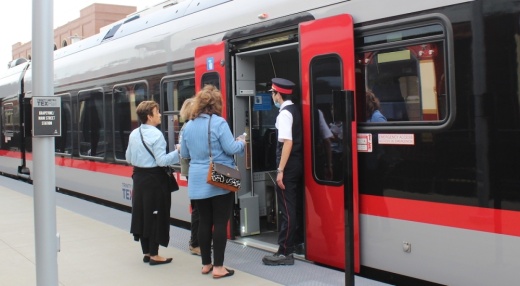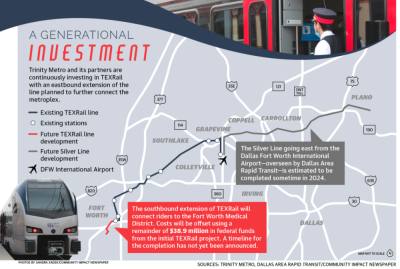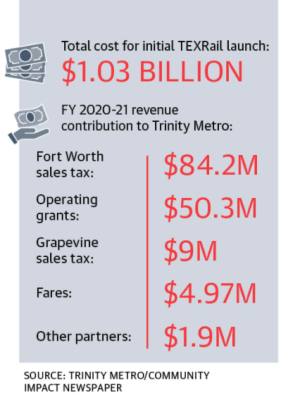Curry said the main reasons she opts for the train over her car is “it’s cheap, and it’s less stressful.”
“[The ride] makes it more fun to drive out here, so that you don’t have to find parking,” she said.
Curry is one of over 300,000 riders who have used TEXRail in fiscal year 2020-21, which runs from October to September, according to data from Trinity Metro, Fort Worth’s transportation authority overseeing TEXRail.
Since January 2019, TEXRail has welcomed nearly 1 million riders across its nine stations between Dallas Fort Worth International Airport and downtown Fort Worth. The $1 billion commuter train was projected to welcome nearly 14,000 daily riders by 2030.
Trinity Metro data shows 1,652 daily riders used the train in December 2019, just one year since opening. Those numbers plummeted during the pandemic to just 350 average daily riders in April 2020. But, numbers are climbing back up, topping 1,250 average daily riders in September 2021.
Despite reduced ridership over the last 18 months, officials remain optimistic about the commuter train’s success. A 2.1-mile westbound extension to Fort Worth’s Medical District is planned.
Grapevine City Council Member Paul Slechta, who also sits on Trinity Metro’s board of directors, said recent numbers are increasing each month.
“Yes, the numbers dropped, [but] they’re on the rise again. They’re creeping back to even pre-COVID[-19] numbers,” he said.
Grapevine’s transit district
Trinity Metro’s 27-mile project from downtown Fort Worth to DFW Airport’s Terminal B has encouraged participating cities such as Grapevine to look to future urbanization.
In February 2019, Grapevine City Council created the Transit District Overlay, a special zone along Dallas Road that promotes walkability and unique developments. City Manager Bruno Rumbelow said the vision of the transit district depends on the development community and the city working together to create a “cool, energized corridor.”
“There’s a lot of investor interest along the route,” he said. “You don’t snap your fingers and it happens overnight, so it’s definitely a focal point and something that we’ll work on as time goes on.”
City documents note the public-private transit district development agreement with Coury Hospitality—which oversees Hotel Vin—will lead to “some of the most unique land use and development opportunities anywhere within the city, if not the region.” Today, the transit district is anchored by Grapevine Main Station, a historically themed train station that includes a European-style food hall and meeting spaces. The station is adjacent to a 121-room boutique hotel, a 532-space parking garage and a large public plaza.
“The development on Dallas Road is really just going to create a whole new aspect to Grapevine. It’s going to tap into a completely different crowd,” Slechta said.
Trinity Metro data shows Grapevine Main Station is among the most popular stops. Jon-Erik “AJ” Arjanen, vice president and chief operating officer for rail at Trinity Metro, said DFW Airport Terminal B has the highest ridership during the week, followed by Fort Worth Central Station and Grapevine Main Station. On Saturdays, Grapevine ranks first, followed by the North Richland Hills/Smithfield Station and the airport station.
“TEXRail has become a favorite for airport travelers who become accustomed to a reliable, on-time arrival without parking hassles or battling traffic along the way,” Arjanen said. “As our data shows, area residents also like to take day trips to Grapevine and other destinations along the route.”
Grapevine’s investment in its station amenities has made it a leading destination for visitors coming from the west side of the metroplex, said Shannon Stevenson, senior program manager for transit management and planning at the North Central Texas Council of Governments—a 16-county voluntary association of, by and for local governments that addresses urban needs.
NCTCOG works with Tarrant, Dallas and Denton counties to invest in alternative modes of transportation.
“Grapevine and the transit-oriented development that they have done around their station has been very successful,” Stevenson said. “You can get off and immediately have everything to do around. I would almost call it a poster child [of] what we would like all of the stations to look like.”
Grapevine has been working with Trinity Metro to encourage visitors to use TEXRail when they come to the city. Glenn Miller, director of marketing for Trinity Metro, said 8,983 TEXRail rides were accounted for to get to GrapeFest, a four-day event in Grapevine that attracts visitors worldwide.
Miller said data showed “37% of tickets sold at the visitor information center were TEXRail passengers.”
Generational investment
TEXRail was partly funded through federal grants as well as sales tax revenue from Grapevine and Fort Worth. North Richland Hills joined later on.
In 2006, Grapevine voters approved a one cent sales tax, of which 3/8th helps fund TEXRail. Today, Grapevine contributes between $8 million and $9 million in sales tax revenue to Trinity Metro to maintain TEXRail, Rumbelow said.
He said voters got what they were promised when they “took a leap of faith” in 2006.
Slechta said the next step to encourage ridership is to educate people on how to use the train—from buying a ticket to navigating the stops.
Kathy Cloud, Pat King and Molly Campbell of Grapevine decided to ride TEXRail on Nov. 9 to downtown Fort Worth for a day out.
The three women said the reputation of the commuter train encouraged them to try it out. They also noted TEXRail’s cleanliness, convenience and affordability as other factors they considered.••As public transits are working to increase ridership, officials said projects like this one should be given more time to show their full potential.
“[COVID-19] hit the transit community especially hard,” Stevenson said. “We just need to give everything more time. It’s almost like we need to give TEXRail another year and a half to get caught up, at least, if not longer.”
Local investment in alternative modes of transportation is not the only funding coming to North Texas. The recently approved federal Infrastructure Investment and Jobs Act will give Texas $3.3 billion over the next five years for transit development.
“I think [rail] can be successful,” Slechta said. “People in Texas like their cars ... but I think it has to be a part of [the future] because as we continue to grow as an area, can we keep widening [and] building more and more highways?”








